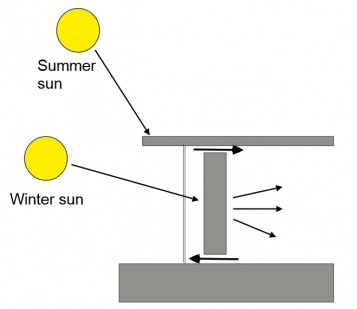Trombe wall
Trombe walls use a combination of thermal mass and glazing to collect and store solar radiation so that it can be used to heat buildings. The broad idea was patented by Edward Morse in 1881, but it was named after French engineer Felix Trombe, who along with architect Jacques Michel used trombe walls as an architectural component in the 1960’s.
A thermally massive wall with good solar absorption characteristics (perhaps with a matt, dark-coloured surface) is orientated facing towards the direction of the sun. The wall is constructed behind a glazed façade that protects it from external conditions. There is generally a space between the glazing and the wall. This space can be very narrow, just sufficient to allow air movement between the glazing and the wall and to provide access for cleaning, or it can be large enough to be habitable.
Solar radiation that penetrates through the glazing will heat up the wall, but the resulting emission of long-wave infrared radiation from the wall will not re-transmit back through the glazing which is opaque to long-wave infrared radiation. This creates an effect similar to that which allows greenhouses to trap solar radiation.
Heat built up in the wall is slowly released into adjacent spaces by radiation and convection. Depending on the thermal mass of the wall, this heat can be released over long periods of time, moderating fluctuations in conditions. This is a form of ‘passive’ solar heating, as opposed to an ‘active’ building services heating system.
The design of trombe walls needs to enable them to provide solar heating during colder periods, but not to generate overheating during warmer periods. This might require the use of external vents, shading or overhanging eaves to limit peak gains and to enable night time cooling.
The design may also include vents at the top and bottom of the wall (which may be controllable or even include mechanical assistance) to allow more rapid heat transfer between the wall and the adjacent space, or it may rely entirely on conduction through the wall. Where vents are included, cooler air from the adjacent space will enter through the lower vent, will be heated by the wall and so will rise, and will then return to the adjacent space through the upper vent. Closing the vents at night will prevent reverse flows occurring and removing heat from the space.
Typically the wall will be 20-40 cm thick, made out of high heat capacity materials such as masonry or concrete (or even containers filled with water), with the absorbed heat taking up to 10 hours to conduct to the interior.
Installations can also include solar thermal systems to generate hot water.
The efficiency of trombe walls can be improved by the use of double glazing with a low-e coating to reduce heat losses to the outside. Low-e coatings reduce the effective emissivity of the surface of glass so that it reflects, rather than absorbs, a higher proportion of long-wave infra-red radiation. Ideally, the glazing should have exterior insulation, shutters or blinds to prevent heat loss during the night.
[edit] Find out more
[edit] Related articles on Designing Buildings Wiki
- Cross ventilation.
- Decrement delay.
- Diaphragm wall.
- Dynamic façade.
- Ground energy options.
- Insulation.
- Low-e glass.
- Natural ventilation.
- Passive building design.
- Passive ventilation.
- Solar chimney.
- Solar thermal systems.
- Stack effect.
- Thermal admittance.
- Thermal labyrinth.
- Thermal mass.
- Types of ventilation.
- Ventilation.
- Wall types.
Featured articles and news
One of the most impressive Victorian architects. Book review.
RTPI leader to become new CIOB Chief Executive Officer
Dr Victoria Hills MRTPI, FICE to take over after Caroline Gumble’s departure.
Social and affordable housing, a long term plan for delivery
The “Delivering a Decade of Renewal for Social and Affordable Housing” strategy sets out future path.
A change to adoptive architecture
Effects of global weather warming on architectural detailing, material choice and human interaction.
The proposed publicly owned and backed subsidiary of Homes England, to facilitate new homes.
How big is the problem and what can we do to mitigate the effects?
Overheating guidance and tools for building designers
A number of cool guides to help with the heat.
The UK's Modern Industrial Strategy: A 10 year plan
Previous consultation criticism, current key elements and general support with some persisting reservations.
Building Safety Regulator reforms
New roles, new staff and a new fast track service pave the way for a single construction regulator.
Architectural Technologist CPDs and Communications
CIAT CPD… and how you can do it!
Cooling centres and cool spaces
Managing extreme heat in cities by directing the public to places for heat stress relief and water sources.
Winter gardens: A brief history and warm variations
Extending the season with glass in different forms and terms.
Restoring Great Yarmouth's Winter Gardens
Transforming one of the least sustainable constructions imaginable.
Construction Skills Mission Board launch sector drive
Newly formed government and industry collaboration set strategy for recruiting an additional 100,000 construction workers a year.
New Architects Code comes into effect in September 2025
ARB Architects Code of Conduct and Practice available with ongoing consultation regarding guidance.
Welsh Skills Body (Medr) launches ambitious plan
The new skills body brings together funding and regulation of tertiary education and research for the devolved nation.
Paul Gandy FCIOB announced as next CIOB President
Former Tilbury Douglas CEO takes helm.























